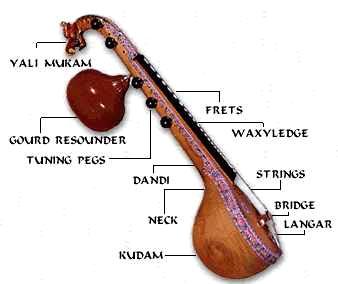Construction: Made of jack wood, the Vina consists of a hollow resonator carved out of a single block of wood that continues as a long fretted neck to which is attached another smaller resonator. The neck curves backwards and at the end is a carved head of a mythological animal. The top of the resonator has a brass-plated bridge through the grooves of which run the 4 main strings. At the end of the main resonator is a string holder. Beyond the bridge are small metal rings, which are attached on one side to the strings and on the other, by thick metal wires, to the string holder. Between the rings and the string holder are small metal coils for fine-tuning. The 4 main strings run along the length of the neck, pass over a grooved plate into 4 tuning pegs, 2 on either side of the neck. The neck is carved out and covered with a thin strip of wood. On both sides of the neck are ledges made of wax on which 24 frets are fixed. Attached to the right side of the main bridge is a curved metal bridge over which pass the 3 tala- strings. These strings are used for keeping the drone and also to indicate the rhythmic cycle. The 3 strings are attached to pegs on the right side of the neck. The small resonator, which is attached under the neck, is either made of papier-mâché or a carved-out gourd. This serves as a second / additional resonator and also as a rest. This gourd is detachable.

Tuning: In ancient times, the Vina had several strings, each tuned to a different note. The modern Vina with a range of three and a half octaves was perfected by Govinda Dikshitar, Prime Minister to the ruler of Tanjavur, Raghunatha Nayak in the 17th century. The last string (i.e. closest to the artiste) which is the main string, is tuned to the tonic note Sa, i.e., the Adhara Shadja, which can be of any convenient pitch. The other strings are tuned in relation to that note. The third string is tuned to the lower fifth perfect, Pa, the second to the tonic note, Sa in the lower octave and the first string, again to Pa, an octave lower than the Pa of the third string. The side strings, (called the Tala strings) are tuned to the tonic Sa, Pa and again, Sa in the higher octave from the top to bottom respectively. Again, if needed, the middle string, Pa could be changed to Ma when Madhyama Sruti is required. In the olden days, the pitch used to be in the range of 4 - 5 kattai (F and G), but it has now been standardised to 2 1/2 (D #).
Posture: The Vina may be held either vertically or horizontally, but it is the latter that is commonly used. The performer sits cross-legged and holds the Vina, with the small resonator resting on the left thigh. The index and the forefinger of the left hand are used to press down on the strings against the frets to produce notes, like a sitar or the guitar. At the same time, the index and the forefinger of the right hand pluck the strings at the lower end. The player normally wears wire plectra on both fingers. Pulling the strings produces ornamentations (gamakas). The little finger is used to pluck the tala strings. This is plucked upwards as opposed to the main strings that are plucked downwards.